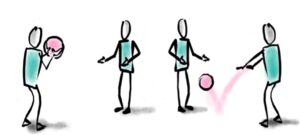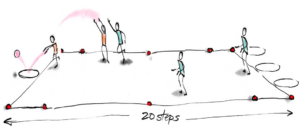Get lesson 1 of all sports: Sign up for a free pe planning membership
Handball
Learning Objectives
- Pass and receive the ball with control.
- Use a range of skills to keep possession of the ball.
- Identify what they do best and what they find most difficult.
Curriculum information
Literacy Keywords
- Ball
- Control
- Pass
- Explore
- Rules
Citizenship
- Working as part of a team
Equipment
- Handballs or suitable balls that bounce and can be held in one hand
- Marker cones
- Hoops
- Bibs
Risk Assessment
- Suitable clothing and footwear worn by participants.
- Equipment suitable for participants, safe and checked.
- Area safe and checked - any hazards removed.
- Safety information highlighted to participants.
- Staff aware of all emergency procedures, including designated 1st aider.
Knowledge Checks
Throughout this plan you will see ‘Knowledge Checks’ to help you ensure the pupils are acquiring the intended knowledge as the lesson progresses. The two types of knowledge to focus on in PE are:
- Declarative Knowledge: Factual knowledge concerning movement, rules, tactics, strategies, health and participation (best practiced through spoken or written observations of a practical demonstration).
- Procedural Knowledge: Knowing how to apply declarative facts (best practiced through demonstration or participation).
Teacher Notes
- This is the first lesson in the Handball unit of work.
- The intention of the lesson is to give the children the opportunity to experience and explore the game by playing a modified version of handball. There are two reasons for this:
- It is an introduction to handball for the children. It gives them the opportunity to have a go at the game and explore if for themselves.
- It provides an opportunity for you to make an initial assessment of your class’s ability. By observing the children you can make a judgement on their current level and the level at which you should set for teaching the rest of the unit.
Activities & Games
Skill Development and Game
Draw the Letter
3 - 5 mins- All children to work on their own in a set area.
- Call out a letter of the alphabet.
- The children then must move drawing out the shape of the letter on the floor.

Teaching Points
- Find a space
- Move in different ways
- Capital or lower case?
- Build up speed gradually
- Find a space
- Keep control of the ball
- Use the handball 3 steps 1 bounce technique
Progression
- Introduce a ball for each child to dribble whilst drawing out the letters.
To make activity harder:
- Introduce more difficult letters e.g. E, H, B.
- Introduce sequences of letters or whole words.
To make activity easier:
- Use easier letters e.g. I, J, V.
Passing - The Bounce Pass
5 - 10 mins- Split the class into pairs.
- Children should stand facing their partner 8 steps apart.
- Using one hand and an overarm throwing technique the children should experiment with the bounce pass.
- Allow the children opportunity to experiment with where to bounce the ball in relation to their partner.
- Ask the children where they think the ball should bounce in relation to their partner.
- Once they have had an opportunity to experiment, teach the children the correct technique to perform the bounce pass:
– Stand sideways with the non-throwing arm nearest partner
– Weight should be on the back leg (leaning backwards slightly)
– Hold the ball above the head to begin with
– Rotate the body leading with the elbow of the throwing arm
– As the arm comes through release the ball as it passes the head
– The ball should bounce two thirds of the way to their partner

Teaching Points
- Highlight and encourage the use of good technique
- Use suitable amount of power – so the ball reaches your partner but do not overthrow so it is difficult to catch the ball
- Where should the ball bounce?
To make activity harder:
- Move the pairs further apart.
To make activity easier:
- Move the pairs closer together.
Knowledge Check
- PROCEDURAL KNOWLEDGE: Ask some children to demonstrate the activity/skill.
- DECLARATIVE KNOWLEDGE: Ask other children to describe what is required to perform the task with success.
Invasion Game
20 - 25 mins- The aim of the game is to score more goals than the opposition.
- Play the game using handball skills – passing, shooting and dribbling – the dribbling should be restricted to 3 steps in the interest of teamwork.
- Play this end-to-end game on a pitch that is approximately 10 steps by 20 steps (wider than it is long).
- Play three against two, and later, four against three.
- Put three small goals (hoops) at one end of the pitch (for the team of three) and one large goal (hoop) at the other end (for the team of two).
- The aim of the game is to use passing and teamwork skills to progress towards the opponents goal (hoop(s)) and score points.
- There is no physical contact allowed in the game.
- The team of three takes all re-start passes from its goal line after a goal has been scored or if the ball goes out of play.
- Keep rotating the teams so everyone gets the opportunity to play the game on the team of two.

Teaching Points
- Introduction to Handball / Invasion Games
- What skills do you need to use? Ask the children to think about this as they play the game
- Experiment with different ideas and skills
- How can you score points? Ask the children to think about this as they play the game
- Observe children whilst playing the game – are they able to play it successfully?
- Is this the correct level at which to teach the rest of your unit?
- Provide advice and guidance if necessary
- Explain the rules and how the game works then let the children explore the game for themselves
- Let the children have a go at the game
Adaptations and variations on the task
- Play the game with the goals (hoops) spread out in different patterns across the goal line.
- Play with a larger number of goals (hoops).
- Play with goals that are worth different points, depending on how difficult they are, e.g. targets in the middle of the pitch are worth more than targets in the corner, smaller targets are worth more than larger targets.
- Play on a pitch that is longer than it is wide.
- Play with an area in front of the goals where nobody can go, so it is harder to defend the goals.
Knowledge Check
- PROCEDURAL KNOWLEDGE: Ask some children to demonstrate the activity/skill.
- DECLARATIVE KNOWLEDGE: Ask other children to describe what is required to perform the task with success.
Static Stretching
3 - 5 mins- Ask the children to stand in a semi-circle around the teacher.
- Show the children a stretch they must copy.
- Start at the top of the body and work all the way down stretching the major body parts – arms and legs.

Teaching Points
- Hold for 10-12 seconds
- Hold still, don’t bounce
- Watch and copy
- Where can you feel the stretch?
Knowledge Check
What skills did you use to play the game today?
- Encourage the children to think of the skills they used when playing the games.
What did you do well today?
- Encourage the children to think of what they have done well when playing the games.
Get lesson 1 of all sports: Sign up for a free pe planning membership